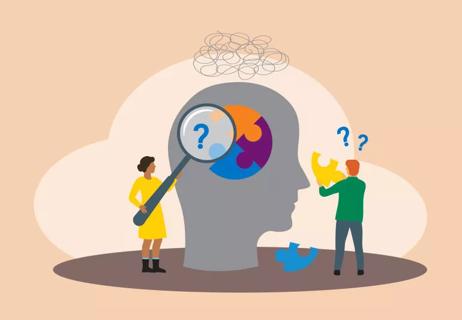Causes range from psychological conditions like PTSD to physical conditions like fibromyalgia

You’re walking to your car late at night when you hear a noise. It could just be the wind rustling the trees, but it could also be something else. Your body tenses. Your breathing becomes shallow. All your senses get a little sharper. When you make it safely to your car, you notice you’re trembling, your palms are sweaty and the hair on your arms is standing on end. Your flight-or-flight instinct kicked in, just like it’s supposed to.
Advertisement
Cleveland Clinic is a non-profit academic medical center. Advertising on our site helps support our mission. We do not endorse non-Cleveland Clinic products or services. Policy
Now imagine those same physical changes happening when you aren’t in a potentially dangerous situation. Imagine it happening every time you leave the house. Every time you introduce yourself at a work function. Every time your partner is 15 minutes late coming home. Your brain and body race far ahead of the facts, so you feel as if there’s danger around every corner.
If that sounds like you, you may be experiencing hypervigilance.
We talked to psychologist Susan Albers, PsyD, about hypervigilance: What it is, what causes it and what to do if it’s negatively impacting your life.
Dr. Albers describes hypervigilance as a heightened state of awareness. “It’s your brain’s way of protecting you by scanning the environment for signs of danger and being extremely aware of your surroundings” she says.
To be clear, hypervigilance isn’t a diagnosis. It’s a symptom that occurs with a wide range of different conditions — both mental and physical. It’s perhaps easiest to think about hypervigilance as a natural instinct gone awry.
“Hypervigilance is a basic human survival mechanism,” Dr. Albers explains. “It allows us to sense predators and threats to our safety. But with hypervigilance, you’re feel like you’re constantly under threat.” Put differently, the amygdala — the part of your brain that’s responsible for managing emotions — is on overdrive.
Advertisement
You’ve probably heard of the fight-or-flight instinct. It’s a mental and physical response to perceived danger. In an attempt to survive, our bodies undergo big physiological changes when we’re threatened. Certain processes — like digestion — slow down. Meanwhile, Dr. Albers says, our bodies get flooded by adrenaline.
“You have higher blood pressure, your heart rate increases, your pupils dilate and your body prepares itself to respond to the threat,” she explains.
All of these changes — and others — serve an evolutionary purpose. You may become pale or flushed, for example, because your body is diverting blood to your brain and limbs. Your muscles may tense up or tremble, primed to react quickly if needed.
When our frontal cortex — the part of our brain that makes decisions — gets flooded with hormones, Dr. Albers says it produces emotions that “are so intense that they knock out any logic or reason.”
These automatic responses are beneficial when we find ourselves in genuine danger. But for people who are hypervigilant, fight-or-flight is the default mode. The result is physical, mental and emotional discomfort.
There’s a long list of medical and mental health conditions that can trigger hypervigilance. That list includes:
Dr. Albers says that hypervigilance is sometimes just a personality trait. “Sometimes, a person is just more aware and mindful of their environment or other people’s feelings, but if hypervigilance is chronic or severe, it’s usually a symptom of a mental health disorder.”
Hypervigilance is also strongly linked to childhood trauma. According to Dr. Albers, that has a lot to do with the fact that, as we grow up, our brain develops in a way that’s responsive to our environment.
She gives the example of a child growing up in an abusive home. “The child is immersed in an unpredictable environment,” she illustrates. “Maybe their parent is sometimes in a good mood and then — out of the blue — becomes enraged or violent. That child will learn how to pick up on very subtle clues because knowing what state their parent is in helps keep them safe.”
When it comes to person with a history of trauma, hypervigilance is about self-protection, about preventing a traumatic situation from happening again.
Advertisement
Hypervigilant behavior looks different depending on who you are and its underlying cause. All of the following are potential examples of hypervigilant behavior:
This kind of hypervigilance is especially common for people who’ve experienced violence — especially if they’re living with post-traumatic stress disorder (PTSD).
Perhaps they have to sit with their backs against the wall to ensure nobody can sneak up behind them. Maybe they have to sleep with the lights on. Perhaps they feel it necessary to have a weapon on hand at all times. They may also have a particularly strong startle reflex, jumping at the slightest noise or motion.
Dr. Albers says it’s common for a person who’s hypervigilant to watch the people around them diligently for slight changes in behavior, tone, cadence, body language, written communication or even sentence structure.
“These individuals tend to do a lot of overanalyzing of people’s moods and their expression — even things like text messages,” she explains. These traits are especially common in people who’ve endured abuse or been exposed to violence.
It doesn’t get as much attention as some other forms of trauma, but medical trauma is very real. Dr. Albers sees it frequently: People who’ve experienced severe illness (their own or a family member’s), major medical procedures, mental health crises or an extended hospitalization or disability can become aware of their own bodies to a degree that’s detrimental. It can cause hypervigilance-related health anxiety.
Advertisement
A minor ache or pain may get them concerned that their cancer is out of remission. A bad day could be misinterpreted as a sign that their depression’s returned. The result can be a vicious cycle: All that worrying causes physical symptoms that are, well, worrying.
“When a person catastrophizes,” Dr. Albers says, “they’re creating a narrative in their head in an attempt to understand a situation. But that narrative gets spun in a negative way.”
A hypervigilant mind tends to be preoccupied by worst-case scenarios. Not getting a call back within a couple of hours may get read as a sign that a loved one has died and a slow response to a message signals the end of a years-long friendship.
The tendency to catastrophize may make it hard to let one’s guard down and enjoy happy moments. When life is going really well, a person living with hypervigilance may find themselves anxious, waiting for the next shoe to drop.
It’s normal to change your behavior in response to a traumatic experience, but a person who’s hypervigilant takes that natural response too far.
If, for example, a person’s in a bad car accident, it’s understandable that they’d want to buy a car with a top safety rating. Never driving again — even if it means losing out on job opportunities, missing family vacations and relying on others for transportation — is an overreaction. In extreme cases, a hypervigilant individual may go on to develop full-fledged agoraphobia — a fear of places, people or situations that they see as threatening.
Advertisement
Hypervigilance can also impact your education, career and other areas of your life. “Some people have difficulty trying new activities or even learning new things because they’re afraid of not being good at it,” Dr. Albers notes. “They might worry that other people will judge or not like them if they aren’t perfect.”
Hypervigilance is all about identifying, responding to or preventing threats as soon as possible — whether those threats are real or perceived. For people with a history of trauma that can happen in many different ways.
Hypervigilant people may struggle with clinginess, people-pleasing, emotional regulation problems and trust issues. They often neglect their own needs (or even suppress elements of their identity) to avoid conflict. The concepts of relationship OCD and good girl syndrome tend to fit neatly under this umbrella.
“Hypervigilance makes it hard for people to relax at all. They always feel awkward or worried that they’re doing or saying something wrong,” Dr. Albers says.
One of the things that makes hypervigilance difficult to deal with is the fact that it’s a legitimately helpful instinct. We should all be hypervigilant in certain situations. But when we’re in nonstop fight-or-flight mode, it can wreak havoc on our bodies, our minds and our relationships.
The impact of one’s body being constantly flooded with adrenaline and cortisol is no small thing.
“Over time, you become exhausted,” Dr. Albers says. “You may experience frequent physical illness, you may have difficulty sleeping, you might find yourself eating too much or not enough. You can even experience gastrointestinal problems from your body being in constant fight-or-flight mode.”
The result of all that pressure? Your mental state — and even your behavior — may change. You could find you struggle to pay attention when that’s not been an issue in the past. You might be more irritable, more inclined to fight with others or more likely to have emotional outbursts. You could isolate yourself from others or experience mood issues like depression.
All too often, people struggling to sleep, regulate their emotions or endure chronic stress turn to substances to cope. While it may seem to help in the moment, self-medicating ultimately makes things worse — especially if there’s an underlying mental health issue involved.
When it comes to relationships of all kinds, hypervigilance is a double-edged sword.
Dr. Albers concedes that an individual with hypervigilant tendencies may notice negative behavior, lying or red flags more quickly than the average person. “Hypervigilance can prevent a lot of conflict,” she says. “An individual who’s hypervigilant might hear a slight shift in someone’s tone and know not to go there.” It may also help you to spot someone whose behavior doesn’t add up, preventing you from getting into a relationship that could be dangerous or hurtful.
While hypervigilance can protect you from conflict or danger, it can also hurt your relationships. In some cases, Dr. Albers adds that hypervigilance prevents people from getting close to or trusting others. It can also have the opposite effect: It can promote an anxious attachment style. “Needing constant reassurance can drive other people away because they know everything’s fine, but the other person keeps reading into the situation and making assumptions.”
To make things more complicated, hypervigilance may cause somebody person to be overly sensitive to feedback, or to be emotionally volatile. Needing to provide constant reassurance can be frustrating, exhausting and — in some cases, for some people — insulting.
Another thing that makes hypervigilance difficult to deal with is the fact that those gut feelings sometimes end up being valid.
“People with extreme hypervigilance can be so tuned in to what is happening that their feelings end up being spot on,” Dr. Albers recognizes. That kind of positive reinforcement can be damaging because it can lead a person who’s hypervigilant to accept their understanding of the world around them.
“If a person who’s hypervigilant has enough experiences where they’re spot on, it can almost start to feel like that they can predict the future,” she continues. “That becomes problematic because it leads to over-analyzing, making assumptions and anticipating the worst. Nobody’s gut instinct is always 100% right and we can’t know or control the future.”
If hypervigilance is negatively impacting your life, there are lots of ways to address it. Dr. Albers suggests the following:
Hypervigilance is what happens when our natural flight-or-flight instinct goes into overdrive. People who are hypervigilant are in a constant state of anxiety. It isn’t a diagnosable mental health condition, but it’s a common feature of a wide range of physical, psychological and thought disorders. Causes range from childhood trauma and personality disorders to physical conditions like hypothyroidism. Hypervigilance can be physically, mentally and emotionally exhausting. It can make daily life and relationships difficult.
If you’re experiencing hypervigilance, consider reaching out to your primary care provider or a mental health professional for help. You may also benefit from limiting your caffeine and alcohol intake, starting a mindfulness practice and learning self-soothing techniques you can use to ground yourself in the present moment.
Learn more about our editorial process.
Advertisement

Fishing for compliments, provoking conflict and pouring on the melodrama are all ways of expressing an unmet need

By setting boundaries around how much you give, you can save your time and resources while also being a good person

Certain B vitamins, omega-3 fatty acids and a healthy diet can serve as complementary treatments for schizophrenia

Following your treatment plan, finding a community, staying active and maintaining a healthy diet can help manage this psychiatric condition

Whether it’s playing hooky or faking cancer, malingering behavior is always motivated by personal gain

Always putting others’ happiness before your own can build resentment over time

Emotional changes, isolation and unusual behavior could signal the onset of the condition

People with schizoaffective disorder have additional mood symptoms

Start having sex about 72 hours before ovulation, then at least every other day during your fertile window

Attachment theory suggests that your earliest relationships shape connections throughout your life

It isn’t a recognized mental health disorder, but research shows that problematic social media use can negatively affect your mental health, self-esteem and sleep